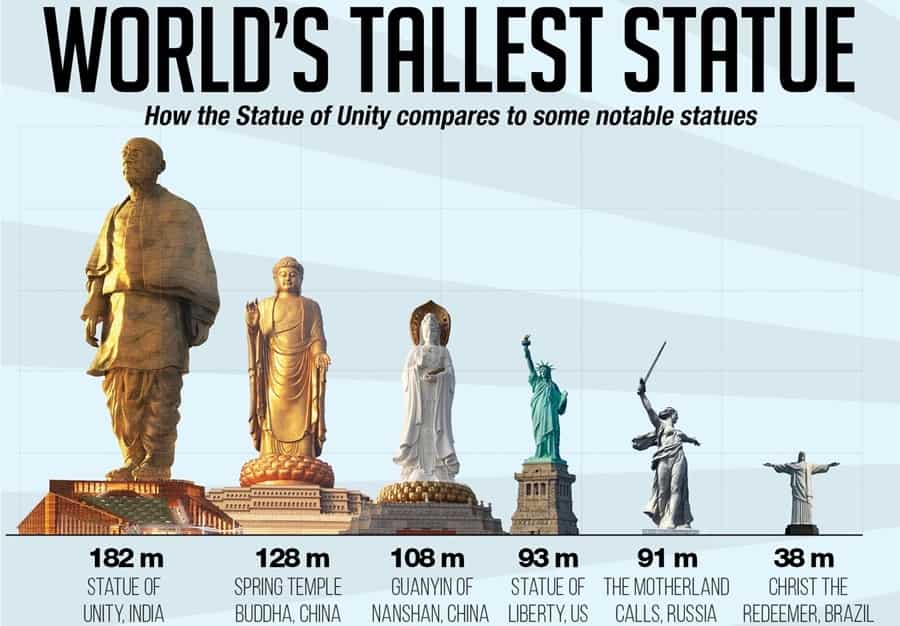The Statue of Unity, standing tall on the banks of the Narmada River in the Indian state of Gujarat, is not just a colossal sculpture but a symbol of unity, strength, and the visionary leadership of Sardar Vallabhbhai Patel, the Iron Man of India. Here are some fascinating facts about the Statue of Unity that contribute to its significance and impact.

1. Monumental Tribute to Unity: The Statue of Unity, unveiled on the 143rd birth anniversary of Sardar Vallabhbhai Patel, serves as a colossal tribute to India’s first home minister, renowned for uniting 562 princely states to form the Republic of India.
2. Vision of Narendra Modi: The concept of the statue was introduced by Prime Minister Narendra Modi in 2010 when he was the Chief Minister of Gujarat. The foundation stone was laid on October 31, 2013.
3. Acclaimed Sculptor: Designed by Padma Bhushan recipient Ram V Sutar, the statue stands as a testament to the sculptor’s artistic prowess and dedication to capturing the essence of Sardar Patel’s leadership.
4. Funding and Scale: The monumental project, with a price tag of Rs 3,050 crores, was fully funded by the state government. It covers an expansive area of 20,000 square meters and is surrounded by a 12 square kilometer artificial lake.
5. Engineering Marvel: Over 300 engineers and 3,000 workers worked tirelessly for nearly three and a half years to complete the construction of the statue, showcasing remarkable engineering feats.
6. Material Extravaganza: The construction utilized a staggering 70,000 tons of cement, 25,000 tons of steel, and 12,000 bronze panels weighing approximately 1,700 tons.
7. Symbolic Design: The statue’s design, a larger replica of Sardar Vallabhbhai Patel’s statue at Ahmedabad International Airport, was carefully chosen after extensive study by a team of historians, artists, and academics.
8. Scenic Location: Nestled between the Vindhya and Satpura mountain ranges, the Statue of Unity enjoys a picturesque setting next to the Narmada River and the Sardar Sarovar Dam.
9. Global Collaboration: The bronze cladding of the statue, a three-layered structure comprising reinforced cement concrete, steel, and 8mm bronze, was carried out by China’s Jiangxi Toqine Company, showcasing international collaboration.
10. Tallest in the World: Soaring to a height of 182 meters, the Statue of Unity holds the distinction of being the tallest statue globally, surpassing both the Statue of Liberty (93 meters) and China’s Spring Temple Buddha (128 meters).
11. Farmers’ Contribution: Over 129 tons of scrap iron for the statue’s base were donated by a staggering 100 million farmers across India, emphasizing grassroots involvement.
12. Resilience Against Nature: The statue is engineered to withstand significant earthquakes and wind speeds of up to 100 km per second, showcasing its durability and stability.
13. Natural Aging Process: Like the Statue of Liberty, the Statue of Unity will undergo a natural aging process known as oxidation, turning from its original bronze color to green over time.
14. Infrastructural Marvel: Inside the statue’s legs, four high-speed lifts transport visitors to a viewing gallery at a height of 153 meters, offering a panoramic view of the surroundings.
15. Multi-functional Complex: The statue complex goes beyond being a mere sculpture. It houses a 3-star lodging facility, a memorial garden, and a grand museum, providing a comprehensive experience for visitors.
Additional Insights
16. Location Specifics: Positioned on Sadhu Bet island near Rajpipla, the statue faces the Narmada Dam, creating a picturesque and serene environment.
17. Worker and Engineering Contribution: Over 3,000 workers, including 300 engineers from Larsen & Toubro, played a pivotal role in bringing the statue to life, showcasing the collaborative effort of skilled professionals.
18. Community Involvement: Approximately 129 tonnes of iron implements were sourced from nearly 100 million farmers across 169,000 villages, reflecting widespread community participation.
19. Global Workforce: The construction efforts included contributions from over 2,000 Indian workers and several hundred laborers from China, highlighting international collaboration.
20. Public Reception: The project has evoked varied opinions in India, with some criticizing the government’s expenditure, while others have raised concerns about the displacement of farmers to make way for the memorial.
21. Architectural Significance: The statue, designed by Michael Graves & Associates in collaboration with Turner Construction and Meinhardt Group, took around four years to design and construct, reflecting meticulous planning and execution.
22. Cost and Funding Source: The statue cost approximately $430 million (29.9 billion rupees), making it a significant investment in India’s cultural and historical landscape.
23. Massive Material Requirements: The sheer scale of the project is highlighted by the use of 2,500,000 cubic feet of concrete, 5,700 tons of steel structure, and 18,500 tons of reinforced steel rods in the construction.
24. Bronze Panel Details: With around 12,000 bronze panels covering the structure, weighing a staggering 1,700 tons, the statue is a masterpiece of intricate craftsmanship.
25. Tourist Attraction: Positioned 125 miles from the state capital, Ahmedabad, the statue is expected to attract approximately 2.5 million visitors annually, transforming it into a nationalist pilgrimage site.
In conclusion, the Statue of Unity is not merely a sculpture but a symbol of India’s rich history, cultural heritage, and engineering excellence. It stands as a testimony to the collaborative efforts of artists, engineers, and communities, creating a lasting monument that celebrates unity and the legacy of Sardar Vallabhbhai Patel.
Also Read:
Popular Tour Packages
